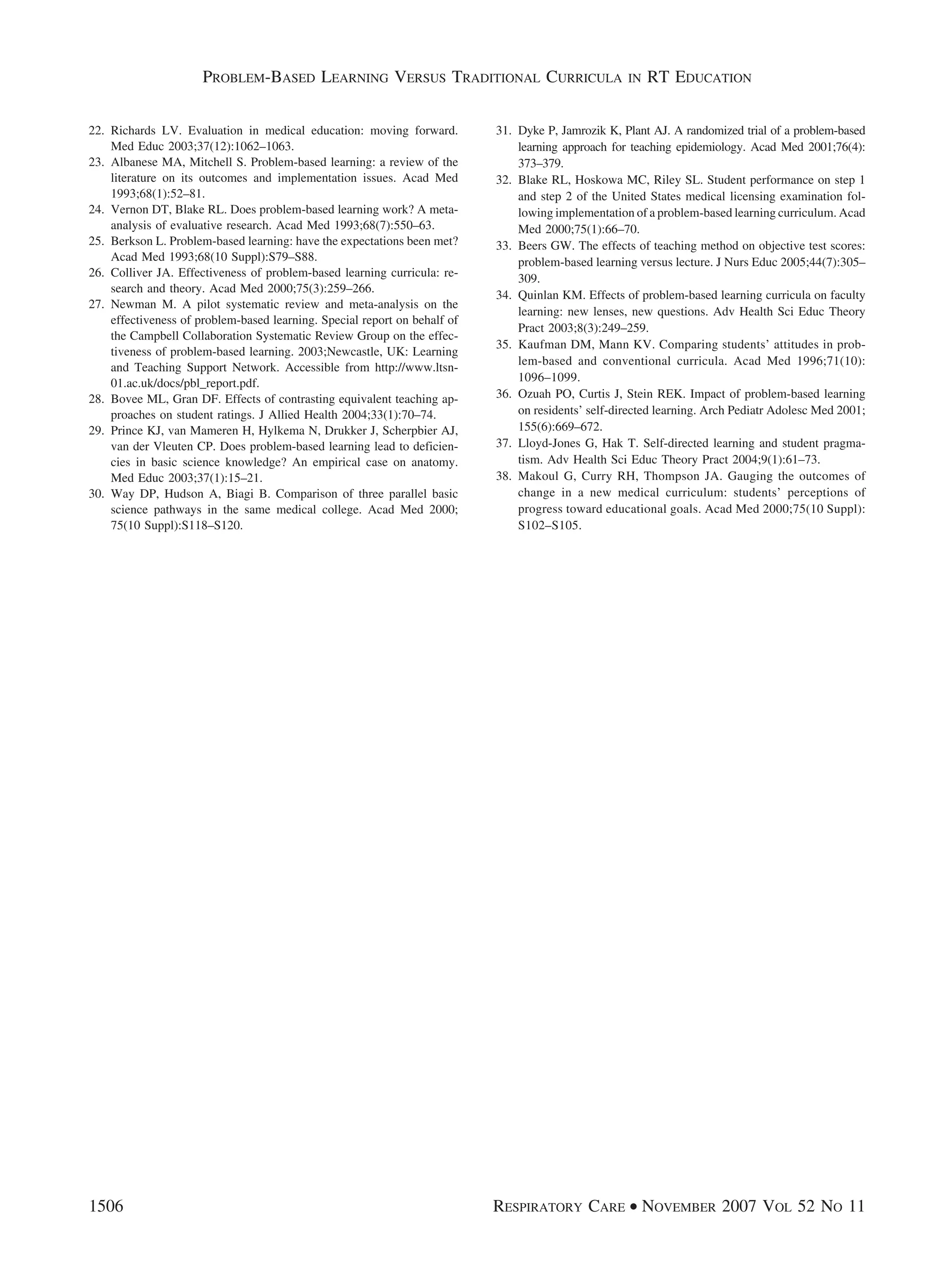This study compared problem-based learning (PBL) and traditional curricula in baccalaureate respiratory therapy programs. The study analyzed survey and examination data from 1999-2002 graduates of two PBL programs and two traditional programs. The key findings were that: 1) Graduates from the PBL programs rated their program's overall quality significantly higher than graduates from traditional programs; and 2) There were no significant differences in scores on national licensing and credentialing exams between PBL and traditional graduates. The study concluded that PBL graduates were more satisfied with their program quality and the PBL method did not place graduates at a disadvantage on standardized tests compared to traditional curricula.
![A Comparison of Problem-Based Learning and Traditional Curricula
in Baccalaureate Respiratory Therapy Education
Will D Beachey PhD RRT
BACKGROUND: Problem-based learning (PBL) is a constructivist model of education that uses
ill-structured, authentic problems to stimulate and organize all learning. The major goal of PBL is
to help learners construct knowledge in contexts similar to the real-world environments in which
the knowledge will be used. Although PBL is a widely accepted educational method, controversy
persists about its effectiveness, how appropriately to measure its outcomes, and, more generally,
whether grand education experiments can explain a curriculum intervention’s effects. The present
study was undertaken to compare PBL and traditional curricula in baccalaureate-level respiratory-
therapy education, in terms of (1) graduate and employer ratings of cognitive, psychomotor, and
affective competencies on standardized follow-up surveys mandated by the Committee on Accred-
itation for Respiratory Care, and (2) scores on the National Board for Respiratory Care (NBRC)
examinations. METHODS: The survey and examination data were collected for the 1999–2002
graduates of 4 baccalaureate degree respiratory-therapy programs in the southeastern and south-
central United States: two that used PBL and two that used conventional curricula. Multivariate
analyses of variance and 2-tailed t tests for independent samples were used to analyze the data.
RESULTS: Although some significant differences were present between the groups in the gradu-
ates’ program-entry characteristics, when considered as covariates, none of the differences were
significant with regard to the survey ratings. Sex did not affect the results of statistical analyses, nor
did the school that the graduates attended. The 2 most important findings were that (1) PBL
graduates rated their programs’ overall quality in preparing them as respiratory therapists signif-
icantly higher than did the traditional program graduates (p ؍ 0.012), and (2) there were no
significant differences in mean scores overall between PBL graduates and traditional graduates on
either the NBRC entry-level examination (p ؍ 0.866) or the NBRC written Registered Respiratory
Therapist examination (p ؍ 0.971). CONCLUSIONS: Respiratory-therapy graduates from the 2
PBL programs were more satisfied with their program’s overall quality than were the graduates of
the 2 traditional-curricula programs. Moreover, the PBL teaching and learning method did not
place graduates at a disadvantage on standardized, objective tests of knowledge (the licensing and
credentialing examinations). These findings are consistent with similar published studies on PBL
approaches in medical and health care professional education. Key words: problem-based learning,
problem-based curriculum, experiential learning, active learning. [Respir Care 2007;52(11):1497–1506.
© 2007 Daedalus Enterprises]
SEE THE RELATED EDITORIAL ON PAGE 1457
Introduction
Problem-based learning (PBL) is a constructivist model
of education in which learning is viewed as a process of
Will D Beachey PhD RRT is affiliated with the Respiratory Therapy
Program, co-sponsored by St Alexius Medical Center and University of
Mary, Bismarck, North Dakota.
The author reports no conflicts of interest related to the content of this paper.
Correspondence: Will D Beachey PhD RRT, St Alexius Medical Center,
900 East Broadway, Bismarck ND 58502. E-mail: wbeachey@
primecare.org.
RESPIRATORY CARE • NOVEMBER 2007 VOL 52 NO 11 1497](https://image.slidesharecdn.com/differencebetweenproblembasedlearningandtraditionalwayofteaching1-180218215244/75/Difference-between-problem-based-learning-and-traditional-way-of-teaching-1-1-2048.jpg)
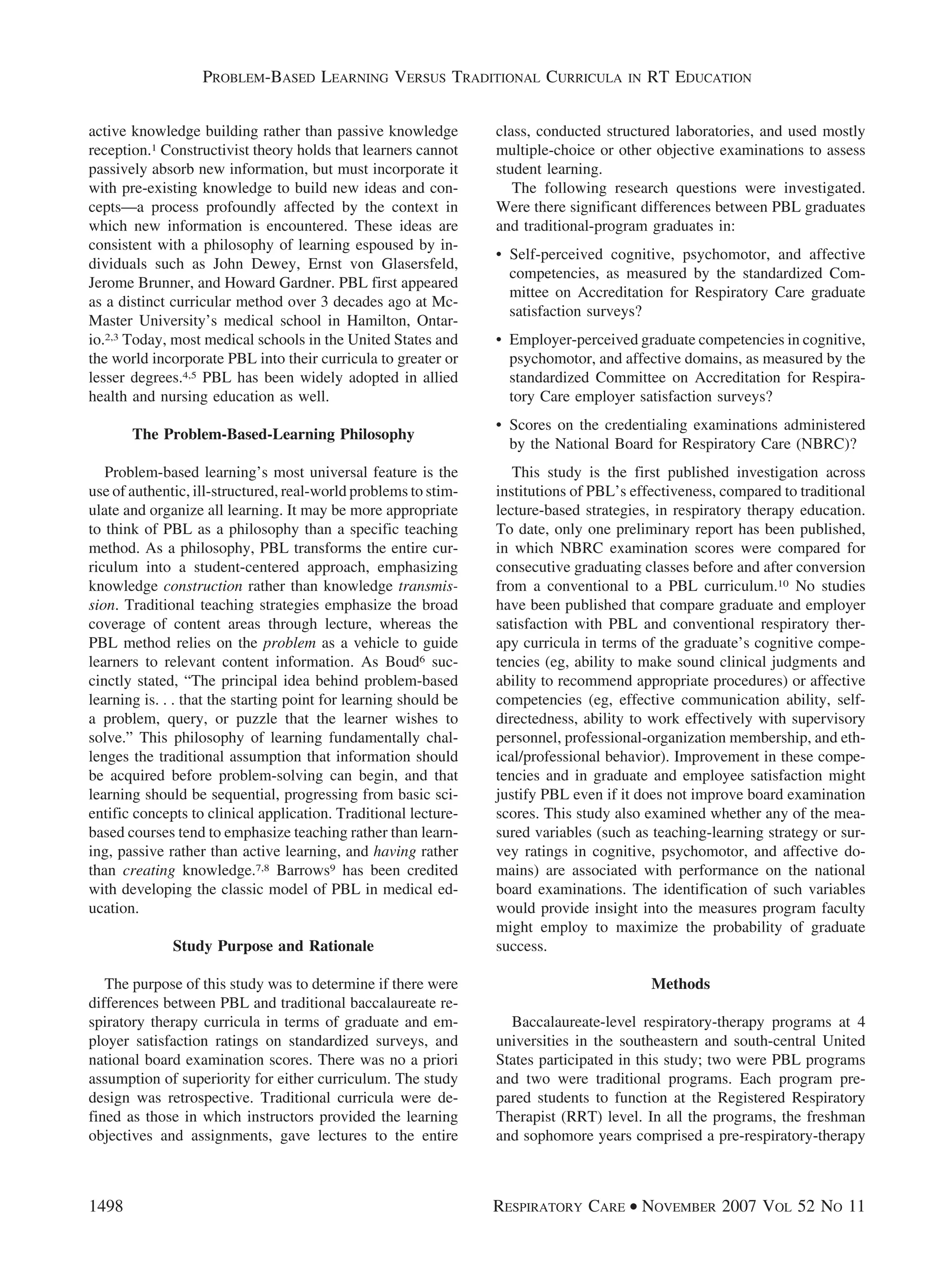
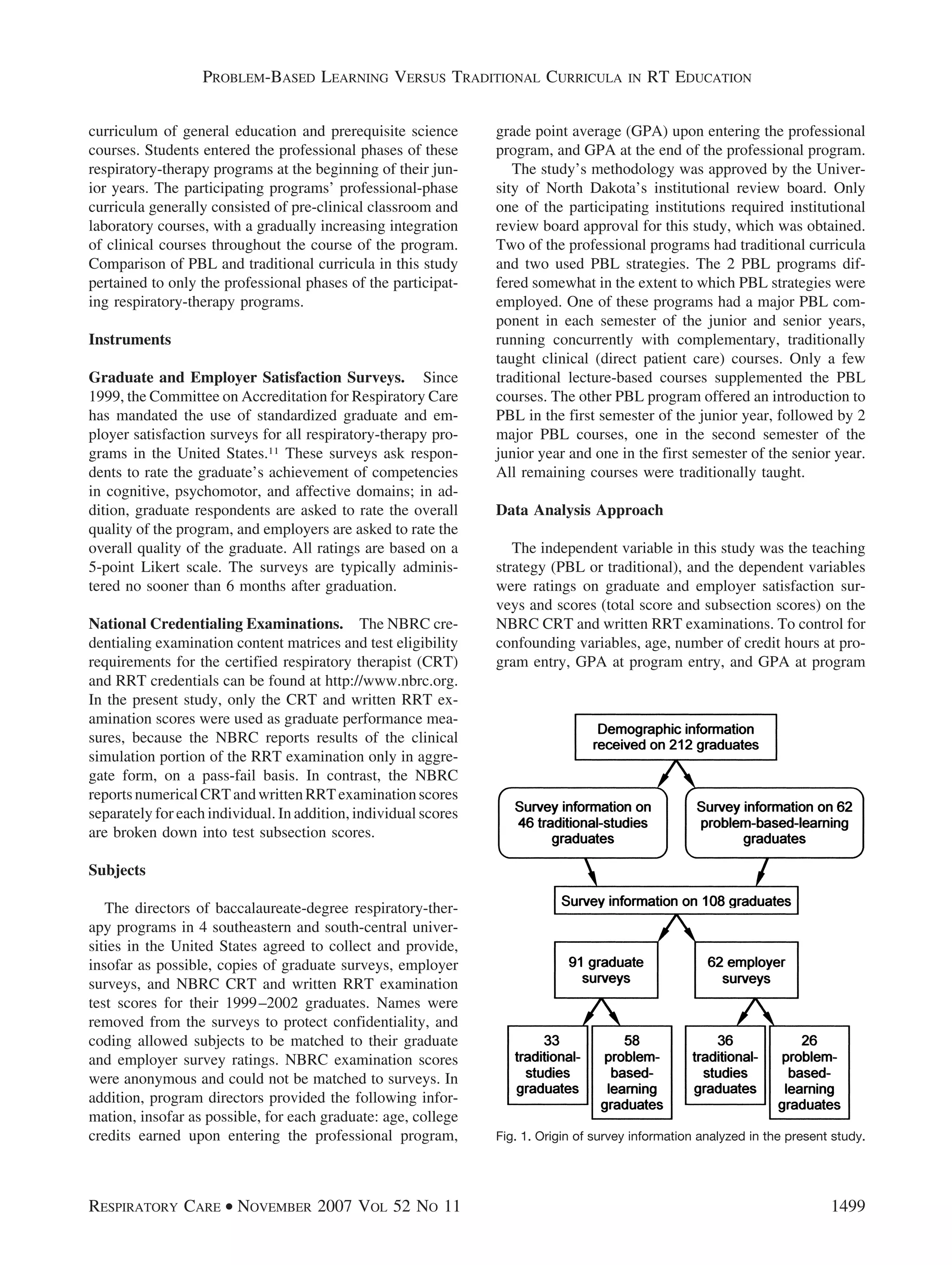

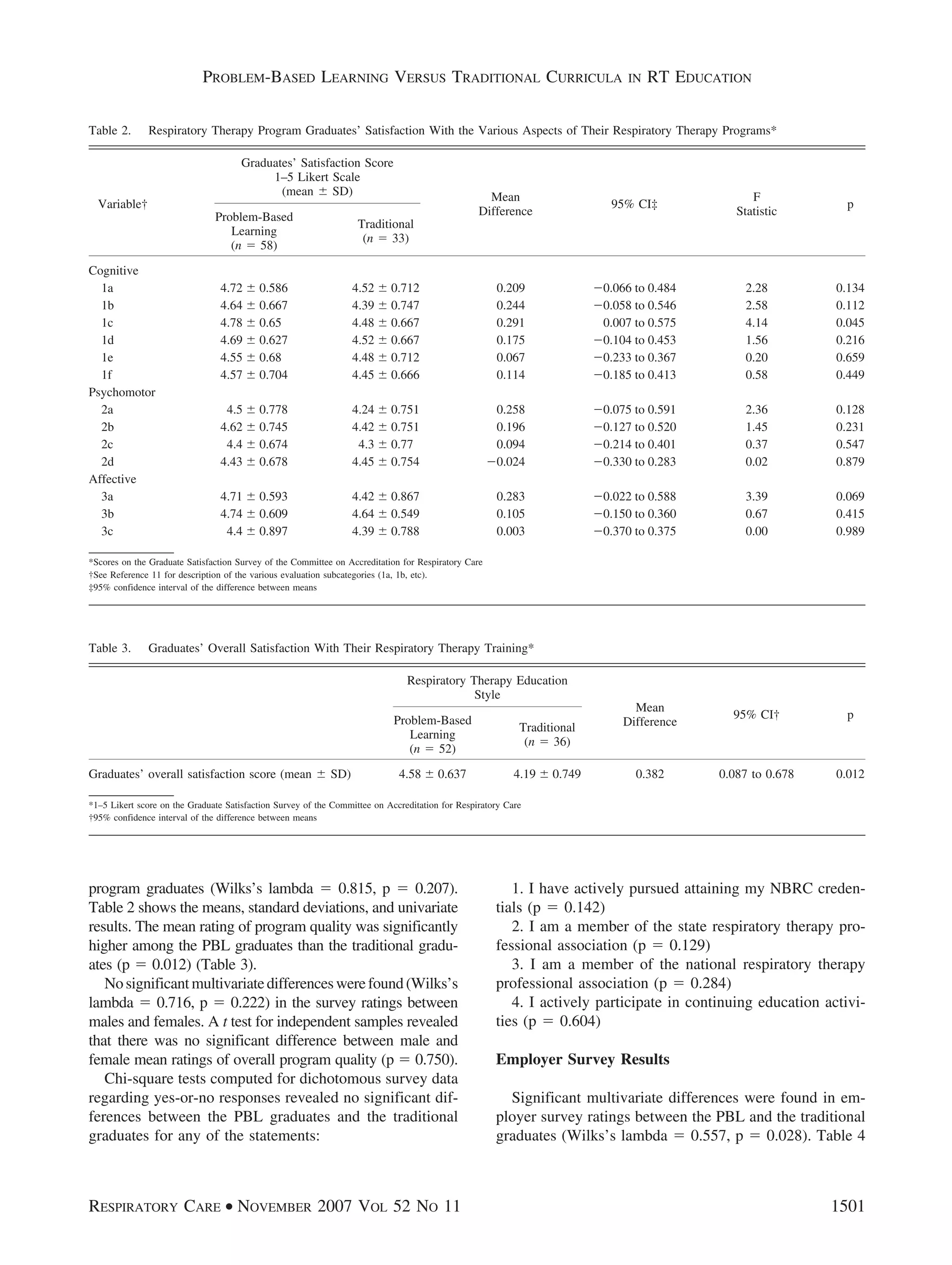
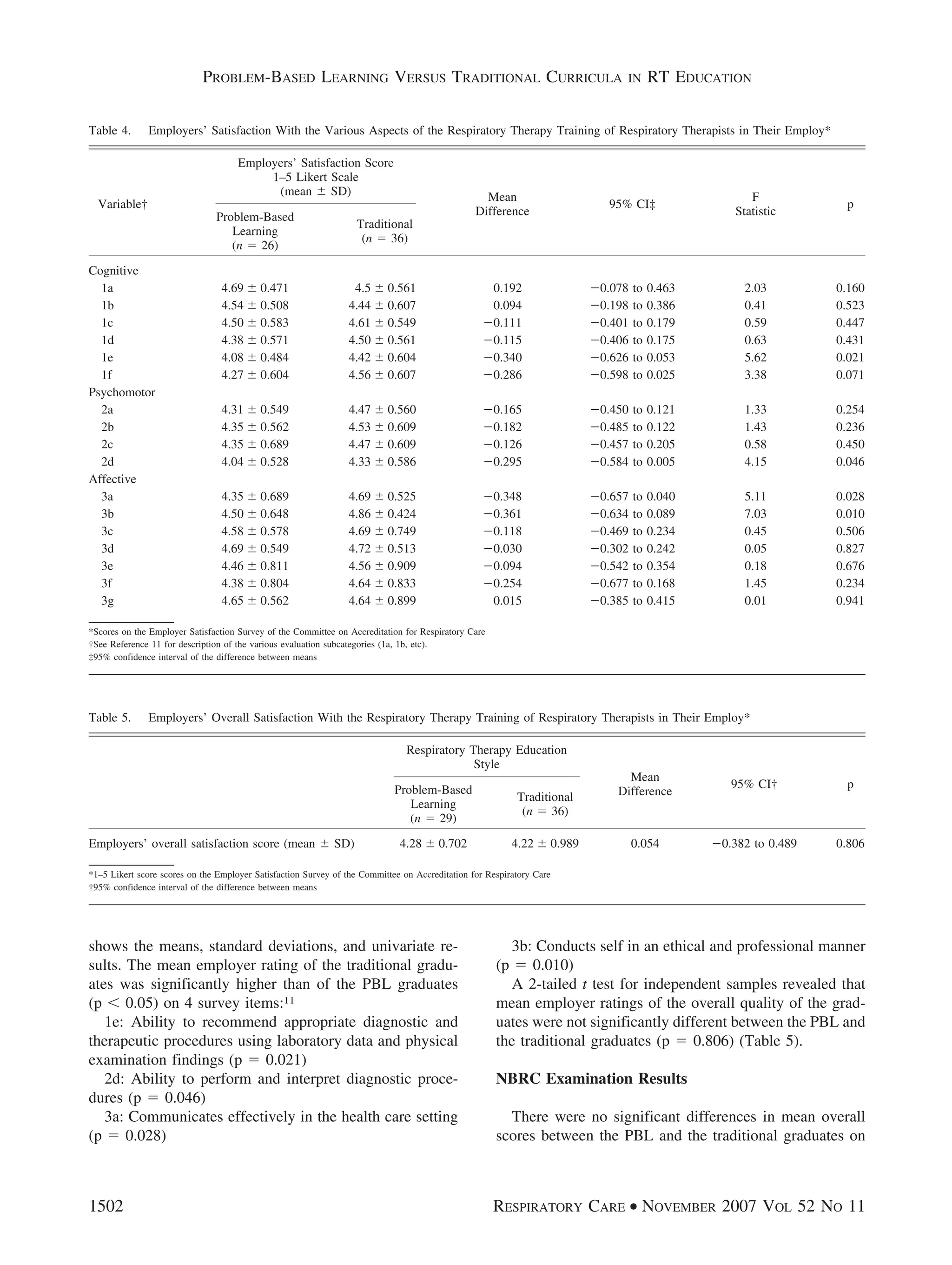
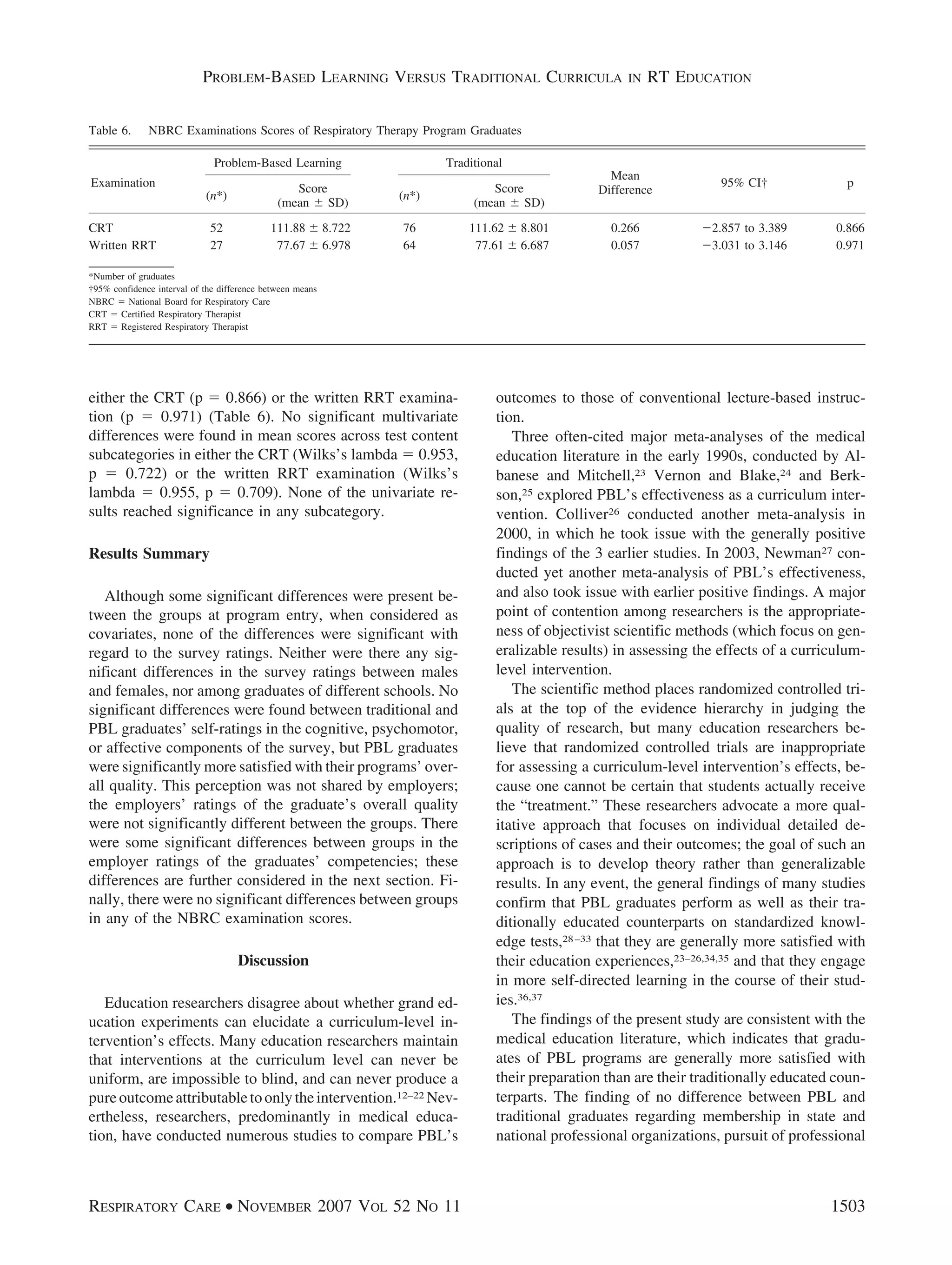
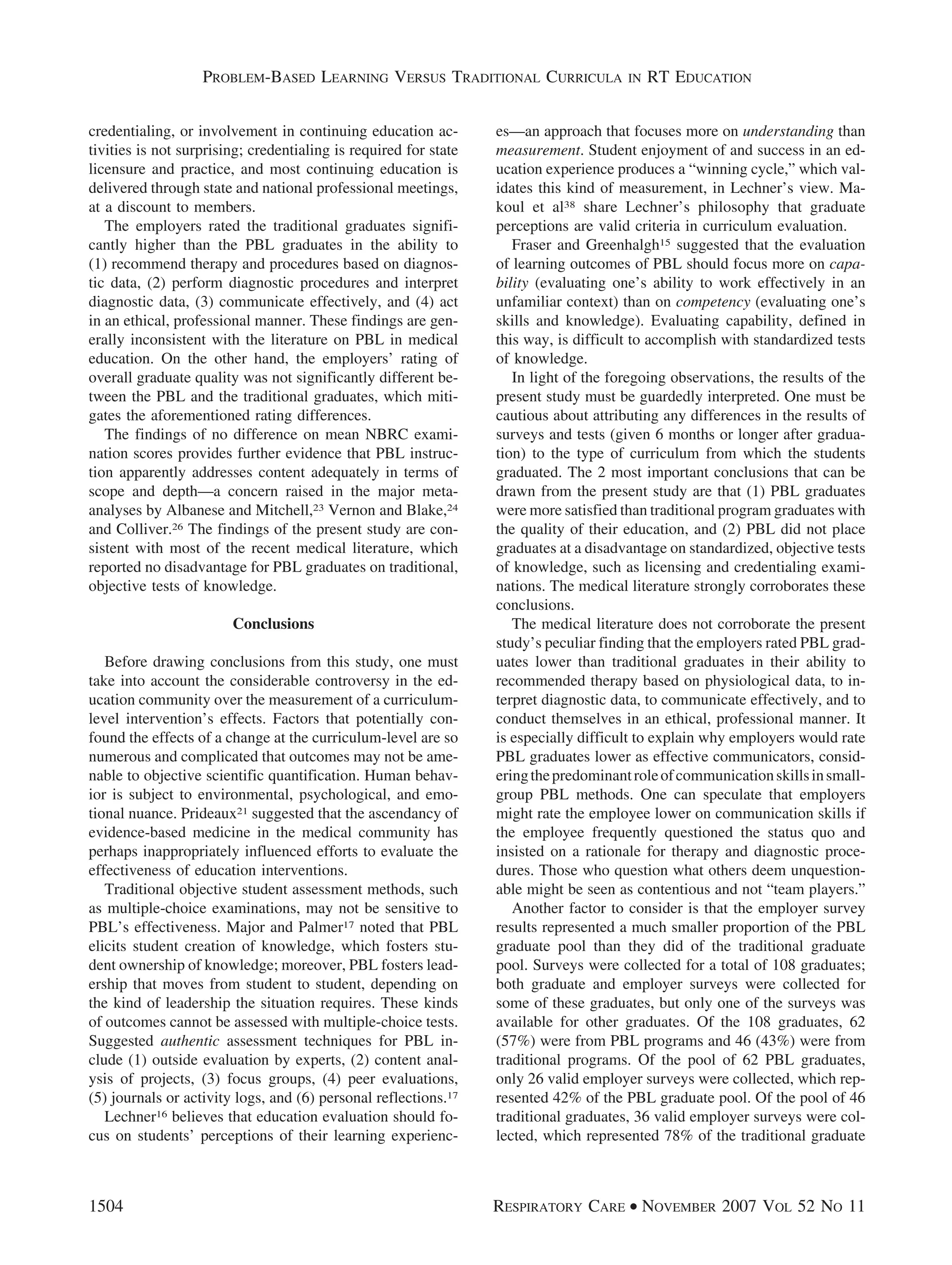
![pool. Thus, the employer survey results do not represent
the PBL graduate pool as validly as they represent the
traditional graduate pool; that is, the employer survey re-
sults cannot be generalized to the pool of PBL graduates
with as much confidence as they can be generalized to the
traditional graduate pool.
The finding that PBL graduates did not rate themselves
higher than traditional graduates in the cognitive domain is
consistent with the literature; a possible reason for the
similarity in self-ratings could be that the clinical patient
care components of both PBL and traditional curricula
were conducted in similar traditional ways, and were pre-
dominant during the latter parts of the programs. To some
extent, clinical education has an inherent PBL-like com-
ponent. Thus, the similarity of clinical experiences in the
latter portions of the curriculum might have masked some
of the differences that would have otherwise appeared be-
tween PBL and traditional curricula. These same reasons
may help explain the finding of no difference between
PBL and traditional graduates in employer satisfaction with
the overall quality of the program’s graduate.
Limitations
This study was retrospective in design and did not em-
ploy random sampling; association between variables does
not indicate causation. A major limitation to the validity of
this study is the amount of time that elapsed between
graduation and completion of the surveys and the NBRC
examinations, which tended to dissociate the statistical
results from the effects of the curriculum. It is possible, as
Colliver26 speculated, that differences between PBL and
traditional graduates in clinical performance are merely a
matter of timing—that once traditional graduates enter the
clinical phases of their programs, they quickly catch up to
PBL graduates in clinical competence. If this is true, it
would help explain why graduates of PBL and traditional
respiratory-therapy programs looked alike to employers in
terms of satisfaction with overall quality of preparation.
The 4 universities from which data were collected rep-
resented different physical learning resources, and oper-
ated under different administrative policies and in differ-
ent socioeconomic and political environments. Student
cultural and socioeconomic backgrounds and attitudes to-
ward learning were undoubtedly different, as were faculty
experience, competence, and attitudes. It is thus reason-
able to speculate that the school attended may have had an
independent effect on survey ratings and examination
scores; however, multivariate analyses of variance across
all graduate and employer survey items and all NBRC
examination subcategories revealed no significant differ-
ences among the 4 participating institutions.
ACKNOWLEDGMENTS
I thank Richard G Landry PhD, Chester Fritz Distinguished Professor,
Educational Research, University of North Dakota, Grand Forks, North
Dakota, for his help in analyzing the data. A special thanks to Shelley C
Mishoe PhD RRT FAARC, Dean, Allied Health Sciences, Medical Col-
lege of Georgia, Augusta, Georgia, for her invaluable assistance in re-
viewing the statistical analysis and the manuscript.
REFERENCES
1. Evensen DH, Hmelo CE, editors. Problem-based learning: a research
perspective on learning interactions. Mahwah (NJ): Lawrence Erl-
baum Associates; 2000.
2. Neufeld VR, Barrows HS. The “McMaster philosophy”: an approach
to medical education. J Med Educ 1974;49(11):1040–1050.
3. Spaulding WB. Revitalizing medical education: McMaster medical
school, the early years 1965–1974. Philadelphia: B.C. Decker; 1991.
4. Camp G. Problem-based learning: a paradigm shift or a passing fad?
Med Educ Online 1996(1);2. Available from http://www.med-ed-
online.org.
5. Edens KM. Preparing problem solvers for the 21st century through
problem-based learning. College Teaching 2000;48(2):55–60.
6. Boud DJ. Problem-based learning in perspective. In: Boud DJ, edi-
tor. Problem-based learning in education for the professions. Syd-
ney: Higher Education Research and Development Society of Aus-
tralasia;1985:13.
7. Chen SE. Problem-based learning: educational tool or philosophy?
Post-conference proceedings from the 2nd Asia-Pacific conference
on problem-based learning, December 2000, Singapore.
8. Greening T. Scaffolding for success in problem-based learning. Med
Educ Online 1998;(3):4. Available from http://www.med-ed-online.org.
9. Barrows HS. A taxonomy of problem-based learning methods. Med
Educ 1986;20(6):481–486.
10. Op’t Holt TB. A first year experience with problem-based learning
in a baccalaureate cardiorespiratory care program. Respir Care Ed-
ucation Annual 2000;9:47–58.
11. Committee on Accreditation for Respiratory Care. Evaluation instru-
ments. http://www.coarc.com/eval_instruments_handbook.htm.
12. Albanese M. Problem-based learning: why curricula are likely to
show little effect on knowledge and clinical skills. Med Educ 2000;
34(9):729–738.
13. Dolmans D. The effectiveness of PBL: the debate continues. Some
concerns about the BEME movement. Med Educ 2003;37(12):1129–
1130.
14. Farrow R, Norman G. The effectiveness of PBL: The debate con-
tinues. Is meta-analysis helpful? Med Educ 2003;37(12):1131–1132.
15. Fraser SW, Greenhalgh T. Coping with complexity: educating for
capability. BMJ 2001;323(7316):799–803.
16. Lechner SK. Evaluation of teaching and learning strategies. Med Educ
Online 2001;(6):4. Available from http://www.med-ed-online.org.
17. Major CH, Palmer B. Assessing the effectiveness of problem-based
learning in higher education: lessons from the literature [electronic
version]. Academic Exchange Quarterly 2001;5:4–9.
18. Maudsley G. What issues are raised by evaluating problem-based
undergraduate medical curricula? Making healthy connections across
the literature. J Eval Clin Pract 2001;7(3):311–324.
19. Norman G. RCTϭresults confounded and trivial: the perils of grand
educational experiments. Med Educ 2003;37(7):582–584.
20. Norman GR, Schmidt HG. Effectiveness of problem-based learning
curricula: theory, practice and paper darts. Med Educ 2000;34(9):
721–728.
21. Prideaux D. Researching the outcomes of educational interventions:
a matter of design. BMJ 2002;324(7330):126–127.
PROBLEM-BASED LEARNING VERSUS TRADITIONAL CURRICULA IN RT EDUCATION
RESPIRATORY CARE • NOVEMBER 2007 VOL 52 NO 11 1505](https://image.slidesharecdn.com/differencebetweenproblembasedlearningandtraditionalwayofteaching1-180218215244/75/Difference-between-problem-based-learning-and-traditional-way-of-teaching-1-9-2048.jpg)
